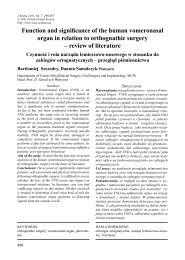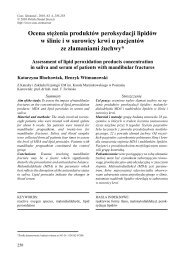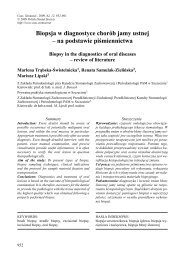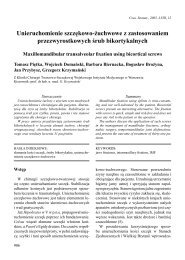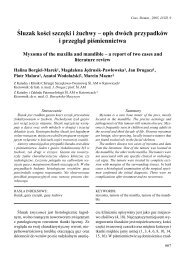pełna wersja do pobrania
pełna wersja do pobrania
pełna wersja do pobrania
You also want an ePaper? Increase the reach of your titles
YUMPU automatically turns print PDFs into web optimized ePapers that Google loves.
J Stoma 2011, 64, 11: 865-874<br />
© 2011 Polish Dental Society<br />
http://www.czas.stomat.net<br />
Multi-disciplinary treatment of a patient<br />
with skeletal malocclusion<br />
Wielospecjalistyczne leczenie pacjentki ze szkieletową wadą zgryzu<br />
Katarzyna Zaleska 1 , Katarzyna Sporniak-Tutak 2<br />
Private Dental Practice, Myślibórz 1<br />
Department of Oral Surgery, Pomeranian Medical University, Szczecin 2<br />
Head: Prof. L. Myśliwiec, DDS, PhD<br />
Summary<br />
Introduction: Malocclusion of a skeletal nature<br />
is among the most difficult conditions to treat and<br />
requires an integrated interdisciplinary effort.<br />
It produces both functional disorders of the<br />
stomatognathic system and aesthetic problems<br />
affecting the patient’s facial features.<br />
Aim of the study: To present the course and results<br />
of treatment of several years’ duration involving a<br />
female patient with a complex skeletal malocclusion<br />
and missing teeth.<br />
Materials and methods: The patient underwent<br />
treatment with Roth system fixed light-wire<br />
appliances, Abosanchor® ortho<strong>do</strong>ntic microscrews,<br />
and Osseo Speed (Astra Tech) dental implants. After<br />
the initial stage of ortho<strong>do</strong>ntic therapy the patient<br />
was referred for orthognathic surgery. Ortho<strong>do</strong>ntic<br />
treatment was continued post-operatively until<br />
proper jaw relationship was achieved. Then,<br />
implant-supported prosthetic reconstruction was<br />
performed.<br />
Results: Complete recovery of the patient’s<br />
stomatognathic system was obtained with significant<br />
improvement of facial aesthetics.<br />
Summary: The scope and complexity of<br />
skeletal malocclusion therapy require complete<br />
understanding and trust. The therapy eliminated<br />
malocclusion, improved stomatognathic system<br />
functions, changed the patient’s aesthetic<br />
appearance, which positively affected her mental<br />
well-being.<br />
KEYWORDS:<br />
skeletal malocclusion, ortho<strong>do</strong>ntic implants,<br />
decompensation, prosthetic rehabilitation<br />
Streszczenie<br />
Wprowadzenie: wady zgryzu o podłożu szkieletowym<br />
są jednymi z najtrudniejszych <strong>do</strong> leczenia i<br />
wymagają działania wielospecjalistycznego. Są powodem<br />
nie tylko zaburzeń czynnościowych układu<br />
stomatognatycznego, lecz także problemem estetycznym<br />
w zakresie rysów twarzy pacjenta.<br />
Cel pracy: opis przebiegu oraz wynik wieloletniego<br />
leczenia pacjentki ze złożoną wadą zgryzu o podłożu<br />
szkieletowym oraz brakami w uzębieniu.<br />
Materiał i metody: zastosowano aparaty stałe cienkołukowe<br />
w systemie Roth, mikrośruby orto<strong>do</strong>ntyczne<br />
Absoanchor®, wszczepy zębowe Osseo Speed<br />
(Astra Tech). Po etapie orto<strong>do</strong>ntycznego przygotowania<br />
u pacjentki wykonano zabieg ortognatyczny.<br />
Po zabiegu kontynuowano leczenie orto<strong>do</strong>ntyczne,<br />
uzyskując <strong>do</strong>pasowanie łuków zębowych, po czym<br />
zastosowano leczenie implantoprotetyczne.<br />
Wyniki: uzyskano pełną rehabilitację układu stomatognatycznego<br />
pacjentki i znaczną poprawę jej<br />
rysów twarzy.<br />
Podsumowanie: zakres i wielokierunkowość leczenia<br />
pacjentki ze szkieletową wadą zgryzu wymagały<br />
pełnego zrozumienia i zaufania. Po leczeniu<br />
uzyskano prawidłowe warunki zgryzowe, poprawę<br />
czynnności układu stomatognatycznego, zmianę<br />
rysów twarzy, co pozytywnie wpłynęło na psychikę<br />
pacjentki.<br />
HASŁA INDEKSOWE:<br />
wada szkieletowa, implanty orto<strong>do</strong>ntyczne, dekompensacja,<br />
rehabilitacja protetyczna<br />
865
K. Zaleska, K. Sporniak-Tutak J Stoma<br />
Introduction<br />
A comprehensive rehabilitation of the<br />
stomatognathic system in patients with skeletal<br />
malocclusion and multiple dental abnormalities<br />
is carried out in stages. The first stage involves<br />
an ortho<strong>do</strong>ntic decompensation of the existing<br />
abnormal occlusion and harmonization of<br />
shapes of both dental arches. The second<br />
stage consists of a surgical correction of the<br />
abnormality, and the last one is restoration of<br />
dental arch continuity by means of prosthetic<br />
replacements.<br />
Aim of the study<br />
The aim of this work is to present the course<br />
and results of treatment of a patient with a<br />
complex skeletal malocclusion and several<br />
teeth missing. The therapy lasted several years.<br />
Case report<br />
A 27-year-old female patient consulted<br />
an ortho<strong>do</strong>ntist for a “crooked” upper left<br />
lateral incisor. After analysis of the patient’s<br />
pantomogram, cephalometric image (Fig.<br />
1, 2) and plaster models, the patient was<br />
diagnosed (according to Polish ortho<strong>do</strong>ntic<br />
diagnostic standards) with a morphological<br />
mandibular prognathism accompanied by<br />
underdevelopment of the upper jaw, crowding<br />
and multiple dental abnormalities, as well as<br />
missing teeth #15, 16, 17, 24, 36, 37 (lost<br />
due to caries). Tooth #46 required en<strong>do</strong><strong>do</strong>ntic<br />
treatment. On extra-oral examination,<br />
prognathic facial features with a longer lower<br />
face height and facial asymmetry were found<br />
(Fig. 3). Intra-oral examination revealed a 2.0<br />
mm overjet in the frontal plane, 1.5 mm reverse<br />
bite on the incisors in the horizontal plane and,<br />
in the midsagittal plane, a 2.0 mm midline shift<br />
to the right of the central incisors in relation<br />
Wstęp<br />
Kompleksową rehabilitację układu stomatognatycznego<br />
u pacjentów z wadami zgryzu<br />
o podłożu szkieletowym oraz licznymi nieprawidłowościami<br />
i brakami zębowymi wykonuje<br />
się etapowo. Pierwszym etapem jest orto<strong>do</strong>ntyczna<br />
dekompensacja istniejącej wady zgryzu<br />
oraz zharmonizowanie kształtu obu łuków<br />
zębowych. Drugim jest chirurgiczna korekta<br />
wady, zaś ostatnim odtworzenie ciągłości<br />
łuku zębowego za pomocą uzupełnień protetycznych.<br />
Cel pracy<br />
Celem pracy był opis przebiegu oraz wynik<br />
wieloletniego leczenia pacjentki ze złożoną<br />
wadą zgryzu o podłożu szkieletowym oraz<br />
brakami w uzębieniu.<br />
Obserwacja<br />
Pacjentka lat 27 zgłosiła się <strong>do</strong> orto<strong>do</strong>nty z<br />
powodu „krzywego zęba” siecznego bocznego<br />
lewego w szczęce. Po analizie pantomogramu,<br />
zdjęcia cefalometrycznego (Fig. 1, 2) oraz modeli<br />
gipsowych rozpoznano wg polskiej diagnostyki<br />
orto<strong>do</strong>ntycznej przo<strong>do</strong>żuchwie morfologiczne<br />
powikłane nie<strong>do</strong>rozwojem szczęki,<br />
stłoczeniami oraz licznymi nieprawidłowościami<br />
zębowymi, brakami zębów: 15, 16,<br />
17, 24, 36, 37 utraconych z powodu próchnicy.<br />
Ząb 46 wymagał leczenia en<strong>do</strong><strong>do</strong>ntycznego.<br />
W badaniu zewnątrzustnym stwierdzono typ<br />
twarzy prognatyczny z wydłużonym <strong>do</strong>lnym<br />
piętrem twarzy oraz asymetrię (Fig. 3). W badaniu<br />
wewnątrzustnym stwierdzono w płaszczyźnie<br />
czołowej nagryz poziomy -2,0 mm, w<br />
płaszczyźnie poziomej odwrotny nagryz zębów<br />
siecznych -1,5 mm, a w płaszczyźnie<br />
strzałkowej przemieszczenie linii pośrodkowej<br />
zębowej pomiędzy przyśrodkowymi zę-<br />
866
2011, 64, 11 Skeletal malocclusion<br />
Fig. 1. Cephalometric X-ray image before ortho<strong>do</strong>ntic<br />
treatment and oral cavity sanation.<br />
Zdjęcie cefalometryczne wykonane przed leczeniem<br />
orto<strong>do</strong>ntycznym i przed jamy ustnej.<br />
Fig. 2. Pantomographic X-ray image before ortho<strong>do</strong>ntic<br />
treatment and oral cavity sanation.<br />
Pantomogram wykonany przed leczeniem orto<strong>do</strong>ntycznym<br />
i sanacją jamy ustnej.<br />
to the to the midline of the upper jaw as well<br />
as a reverse overlap of teeth #35 and #36 over<br />
tooth #14. In the maxilla, a crowding of the<br />
upper incisors and medium grade asymmetric<br />
narrowing between first premolars, according<br />
to Pont’s index, as well as mesialization of teeth<br />
#22-26 and superposition of tooth #23 were<br />
observed. In the mandible, a medium grade<br />
asymmetric narrowing between first premolars,<br />
according to Pont’s index, mesialization of<br />
teeth #43-48 and retrusion of the lower incisors<br />
were diagnosed (Fig. 4).<br />
Cephalometric analysis acc. to Segner-<br />
Hasund revealed a prognathic face, skeletal<br />
Class I, high-angle vertical relation as well<br />
as posterior rotation of the mandible. Once<br />
the patient accepted and gave her consent<br />
to an interdisciplinary ortho<strong>do</strong>ntic-surgicalprosthetic<br />
treatment plan, preparations for<br />
the ortho<strong>do</strong>ntic stage began. It was divided<br />
into several stages. The first one involved<br />
bami siecznymi w stosunku <strong>do</strong> linii pośrodkowej<br />
szczęki w prawo o 2,0 mm i odwrotne<br />
zachodzenie zębów 35, 36 na ząb 14. W szczęce<br />
zaobserwowano stłoczenia zębów siecznych<br />
górnych oraz asymetryczne zwężenie<br />
średniego stopnia wg wskaźnika Ponta pomiędzy<br />
pierwszymi zębami przedtrzonowymi,<br />
mezjalizację zębów 22-26 oraz suprapozycję<br />
zęba 23. W żuchwie zdiagnozowano zwężenie<br />
asymetryczne średniego stopnia wg wskaźnika<br />
Ponta pomiędzy pierwszymi zębami przedtrzonowymi,<br />
mezjalizację zębów 43-48 oraz<br />
retruzję siekaczy <strong>do</strong>lnych (Fig. 4).<br />
Analiza cefalometryczna wg Segnera-<br />
Hasunda, wykazała typ twarzy prognatyczny,<br />
I klasę szkieletową oraz relację wertykalną<br />
wysokokątową i posteriorotację żuchwy. Po<br />
zaakceptowaniu przez pacjentkę planu leczenia<br />
orto<strong>do</strong>ntyczno-chirurgiczno-protetycznego<br />
i uzyskaniu jej zgody, rozpoczęto przygotowanie<br />
orto<strong>do</strong>ntyczne, które podzielono<br />
867
K. Zaleska, K. Sporniak-Tutak J Stoma<br />
Fig. 3. Profile image of the patient before treatment.<br />
Profil pacjentki przed leczeniem.<br />
Fig 4. Intra-oral image before ortho<strong>do</strong>ntic treatment.<br />
Zdjęcie wewnątrzustne pacjentki wykonane przed<br />
leczeniem.<br />
decompensation of the abnormality and<br />
proper teeth alignment. The second stage<br />
aimed at closing as many of the empty spaces<br />
resulting from the lack of teeth as possible;<br />
harmonization of the shapes of the upper and<br />
lower dental arches was also planned. The aim<br />
of this approach was to minimize the number<br />
of necessary prosthetic reconstructions to be<br />
carried out upon completion of the ortho<strong>do</strong>nticsurgical<br />
treatment. In the upper jaw, a<br />
distalization of tooth #23 and mesialization<br />
of teeth #25-27 and #18 were planned in the<br />
frontal plane, intrusion of tooth #13 in the<br />
horizontal plane, and alignment and leftward<br />
displacement of the incisors in the sagittal<br />
plane to obtain alignment of the incisor midline<br />
with the midline of the upper jaw.<br />
In the lower jaw, flaring and alignment of<br />
the mandibular incisors in the frontal plane<br />
were planned. Although the third molars in the<br />
lower jaw were present and sound they were<br />
na kilka etapów. Pierwszym była dekompensacja<br />
wady i uszeregowanie zębów. W drugim<br />
orto<strong>do</strong>ntyczne zamknięcie jak największej<br />
liczby przestrzeni po utraconych zębach<br />
oraz zharmonizowanie kształtu łuku zębowego<br />
górnego z łukiem <strong>do</strong>lnym. Celem takiego<br />
postępowania było ograniczenie <strong>do</strong> minimum<br />
liczby uzupełnień protetycznych, których wykonanie<br />
przewidziano po zakończeniu leczenia<br />
orto<strong>do</strong>ntyczno-chirurgicznego. W szczęce<br />
w płaszczyźnie czołowej zaplanowano dystalizację<br />
zęba 23, mezjalizację zębów 25-27<br />
i 18, w płaszczyźnie poziomej intruzję zęba<br />
13, zaś w płaszczyźnie strzałkowej uszeregowanie<br />
i przemieszczenie zębów siecznych w<br />
lewo w celu wyrównania linii pośrodkowej.<br />
W żuchwie w płaszczyźnie czołowej zaplanowano<br />
wychylenie i uszeregowanie zębów<br />
siecznych <strong>do</strong>lnych. Pacjentka posiadała <strong>do</strong>lne<br />
trzecie zęby trzonowe, bez wypełnień, które<br />
usunięto przed zabiegiem ortognatycznym.<br />
868
2011, 64, 11 Skeletal malocclusion<br />
sacrificed prior to orthognathic surgery. Thus,<br />
the decision was made to extract tooth #46,<br />
mesialize teeth #47 and #48 on one side and<br />
tooth #38 on the other side of the dental arch.<br />
Fixed light-wire appliances, based on Roth<br />
system slot 0’22, were used for decompensation<br />
of malocclusion. Absoanchor® microscrews<br />
were used for mesialization of the posterior<br />
teeth. These were inserted into the space<br />
between roots of teeth #43 and #44 and into the<br />
edentulous gap of the alveolar process behind<br />
tooth #35. After 33 months of ortho<strong>do</strong>ntic<br />
treatment a surgical procedure was planned.<br />
At this point, with the help of the cephalometric<br />
analysis, a careful profile and en face<br />
analysis of the patient’s soft tissue was carried<br />
out. 1,2 The position of the lips both at rest and<br />
in a full smile was analyzed. A surgery of both<br />
the upper and lower jaw was planned based on<br />
these results. It involved Le Fort I osteotomy –<br />
the upper jaw protrusion and placing it in symmetric<br />
alignment in the horizontal plane, also<br />
bilateral, sagittal osteotomy of the mandible<br />
resulting in its retraction, “counter-clockwise”<br />
rotation of the upper-lower jaw complex as<br />
well as genioplasty. 2-5 The aim of the surgery<br />
was to correct the advanced morphological<br />
malocclusion and to improve the aesthetics of<br />
the patient’s facial features.<br />
Intermaxillary surgical splints were prepared<br />
in a prosthetic laboratory. After making the<br />
plaster models, the patient’s bite in centric<br />
occlusion was recorded. A face-bow was used<br />
to record the position of the upper jaw relative<br />
to the base of the skull. 5 These models were<br />
placed in an articulator and a simulation of<br />
the surgery first on the upper jaw and then<br />
on the lower jaw was carried out utilizing the<br />
data obtained during the clinical examination<br />
and cephalometric analysis. 6 The patient was<br />
then referred to hospital where the surgery was<br />
carried out. The bone segments resulting from<br />
Podjęto decyzję o ekstrakcji zęba 46 i mezjalizacji<br />
zębów 47 oraz 48 po jednej stronie, a<br />
także mezjalizacji zęba 38 po drugiej stronie<br />
łuku zębowego.<br />
Do dekompensacji wady zgryzu zastosowano<br />
aparat stały cienkołukowy w systemie<br />
Roth o slocie 0`22. Do mezjalizacji zębów<br />
tylnych użyto mikrośrub Absoanchor®, które<br />
wprowadzono w przestrzenie pomiędzy korzenie<br />
zębów 43 i 44 oraz w bezzębną część<br />
wyrostka za zębem 35. Po 33 miesiącach leczenia<br />
orto<strong>do</strong>ntycznego zaplanowano zabieg<br />
chirurgiczny.<br />
Posługując się wynikami analizy cefalometrycznej,<br />
<strong>do</strong>konano analizy tkanek miękkich<br />
pacjentki zarówno z profilu jak i en<br />
face. 1,2 Zbadano układ ust w spoczynku oraz<br />
w szerokim uśmiechu. Na podstawie uzyskanych<br />
danych zaplanowano zabieg: osteotomię<br />
szczęki typu Le Fort I – jej wysunięcie<br />
oraz ustawienie symetrycznie w płaszczyźnie<br />
horyzontalnej, a także obustronną, strzałkową<br />
osteotomię żuchwy z jej cofnięciem.<br />
Równocześnie zaplanowano rotację „counter<br />
clockwise” kompleksu szczękowo-żuchwowego<br />
oraz plastykę bródki. 2-5 Celem zabiegu<br />
miała być korekta zaawansowanej morfologicznej<br />
wady zgryzu oraz poprawa estetyki<br />
rysów twarzy pacjentki.<br />
W laboratorium protetycznym przygotowano<br />
międzyzębowe szyny śró<strong>do</strong>peracyjne.<br />
Po wykonaniu modeli gipsowych, zarejestrowano<br />
zgryz pacjentki w zwarciu centralnym.<br />
Pozycję szczęki w stosunku <strong>do</strong> podstawy<br />
czaszki zarejestrowano z wykorzystaniem<br />
łuku twarzowego. 5 Tak przygotowane modele<br />
zamontowano w artykulatorze, gdzie wykonano<br />
symulację zabiegu najpierw na szczęce,<br />
a później na żuchwie, przenosząc dane<br />
otrzymane z badania klinicznego i analizy<br />
cefalometrycznej. 6 Następnie wykonano zabieg.<br />
Odłamy osteotomijne unieruchomiono<br />
869
K. Zaleska, K. Sporniak-Tutak J Stoma<br />
Fig. 5. Cephalometric X-ray image after surgery.<br />
Zdjęcie cefalometryczne wykonane po zabiegu.<br />
Fig. 6. Pantomographic X-ray image after surgery.<br />
Pantomogram wykonany po zabiegu.<br />
osteotomy were fixed by means of titanium<br />
plates and screws (Fig. 5, 6). Interarch elastics<br />
were placed for 6 weeks for the purpose of<br />
muscular rehabilitation.<br />
Results<br />
The patient continued wearing fixed<br />
appliances after the surgery in order to align<br />
the dental arches and complete mesialization<br />
of teeth #38 and #48. Dental implants were<br />
inserted at 7 months postoperatively to serve<br />
as abutments for future replacements of the<br />
missing teeth #16 and #36. The fixed appliances<br />
were removed once the ortho<strong>do</strong>ntic treatment<br />
was complete and the patient received retainers<br />
which she was instructed to wear 24 hours<br />
a day until completion of the prosthetic<br />
reconstruction. She was further instructed to<br />
wear the retainers every night for six months<br />
and then every second night for another six<br />
months. Prosthetic crowns were placed on<br />
za pomocą tytanowych płytek i śrub (Fig. 5,<br />
6). Założono wyciąg elastyczny, który utrzymano<br />
przez 6 tygodni celem rehabilitacji mięśniowej.<br />
Wyniki<br />
Po zabiegu pacjentka nadal nosiła aparaty<br />
stałe w celu <strong>do</strong>pasowania łuków zębowych<br />
i <strong>do</strong>kończenia mezjalizacji zębów 38 i 48.<br />
Po 7 miesiącach od zabiegu ortognatycznego<br />
pacjentce założono wszczepy śródkostne dla<br />
odbu<strong>do</strong>wy brakujących zębów 16 i 36. Po zakończonym<br />
leczeniu orto<strong>do</strong>ntycznym zdjęto<br />
aparaty stałe i założono płyty retencyjne, które<br />
pacjentka miała nosić przez 24 godziny na<br />
<strong>do</strong>bę, aż <strong>do</strong> momentu wykonania uzupełnień<br />
protetycznych. Następnie zalecono, aby płyty<br />
retencyjne stosować przez pierwsze 6 miesięcy<br />
w nocy, zaś przez następne 6 miesięcy co<br />
drugą noc. Po 9 miesiącach od zabiegu implantacji<br />
wykonano korony protetyczne opar-<br />
870
2011, 64, 11 Skeletal malocclusion<br />
Fig. 7. Profile of the patient after treatment.<br />
Profil pacjentki po leczeniu.<br />
the implants nine months after their insertion<br />
commencing the retention stage of treatment<br />
(Fig. 7, 8).<br />
Discussion<br />
The treatment of adult patients with<br />
skeletal malocclusion is a complex problem.<br />
Morphological problems are often additionally<br />
complicated by missing teeth or caries. The<br />
treatment plan, usually lasting for years,<br />
combines the interdisciplinary efforts of<br />
the ortho<strong>do</strong>ntist, en<strong>do</strong><strong>do</strong>ntist, surgeon and<br />
prosthetist.<br />
Ortho<strong>do</strong>ntic treatment in patients with<br />
missing teeth poses more problems, and often<br />
requires the use of microscrews to provide<br />
additional skeletal attachment points. In the case<br />
presented here, closure of the spaces created<br />
by missing teeth using only fixed appliances<br />
Fig. 8. Intra-oral image upon completion of the interdisciplinary<br />
ortho<strong>do</strong>ntic, surgical and prosthetic<br />
treatment.<br />
Zdjęcie wewnątrzustne pacjentki po interdyscyplinarnym<br />
leczeniu orto<strong>do</strong>ntyczno-chirurgiczno-protetycznym.<br />
te na wszczepach i rozpoczęło etap retencji<br />
(Fig.7, 8 ).<br />
Dyskusja<br />
Leczenie <strong>do</strong>rosłych pacjentów z wadami<br />
zgryzu o podłożu szkieletowym jest złożone.<br />
Problemy morfologiczne często są powikłane<br />
<strong>do</strong>datkowo istniejącymi brakami zębowymi<br />
lub ich próchnicą. Plan leczenia, zwykle wieloletni,<br />
łączy współpracę orto<strong>do</strong>nty, en<strong>do</strong><strong>do</strong>nty,<br />
chirurga i protetyka.<br />
Leczenie orto<strong>do</strong>ntyczne w przypadku istniejących<br />
braków zębowych jest trudniejsze<br />
i nierzadko wymaga zastosowania <strong>do</strong>datkowych<br />
kostnych punktów kotwiących jakimi<br />
są mikrośruby. U opisanej pacjentki zamknięcie<br />
przestrzeni po utraconych zębach aparatem<br />
stałym cienkołukowym nie było możliwe,<br />
gdyż <strong>do</strong>szłoby <strong>do</strong> utraty zakotwienia i<br />
871
K. Zaleska, K. Sporniak-Tutak J Stoma<br />
was not possible as it would produce loss of<br />
possible anchorage and an undesired alignment<br />
change in the anterior segment. 7 Microscrews<br />
were thus used. 8 Thanks to this option, the<br />
extraction of mandibular third molars was<br />
avoided in this patient. The patient tolerated<br />
the additional ortho<strong>do</strong>ntic elements in the oral<br />
cavity well and reported only a slightly more<br />
discomfort from them in comparison with the<br />
remaining ortho<strong>do</strong>ntic elements. 9<br />
The plan of the procedure aimed at both the<br />
improvement of the patient’s facial aesthetics<br />
and achievement of stable and durable<br />
treatments results. 6 It is accepted that the most<br />
important factor limiting the degree to which<br />
bones of the upper/lower jaw massive can be<br />
moved is the skeletal muscles attached thereto.<br />
Excessive stretching of these muscles hinders<br />
proper post-operative rehabilitation, and is the<br />
main cause of why positive results obtained<br />
through surgery are lost. 10<br />
One of the key aspects of obtaining the<br />
expected aesthetic result is the correct<br />
relationship of the upper lip to the incisors both<br />
at rest and while smiling. The ideal situation is<br />
when the central incisors are exposed 1-3 mm<br />
from below the upper lip at rest and become<br />
fully visible during a wide smile. The response<br />
of the soft tissue of the upper lip after the Le Fort<br />
I osteotomy is usually not up to the calculationbased<br />
expectations and is not always 100%<br />
predictable. Another problem that should have<br />
been considered during the planning of the<br />
surgery was the change of location of points<br />
A and B of the facial skeleton which resulted<br />
in a change of the inclination of the upper and<br />
lower incisors (counter-clockwise rotation)<br />
as well as in the appearance of the nasal<br />
area. These post-operative morphological<br />
changes have to be considered during the preoperative<br />
ortho<strong>do</strong>ntic preparation and surgery<br />
planning. 1,2,4<br />
niekorzystnej zmiany ustawienia zębów w odcinku<br />
przednim. 7 Stąd zastosowano mikrośruby.<br />
8 Dzięki takiemu rozwiązaniu odstąpiono<br />
od ekstrakcji trzecich zębów trzonowych w<br />
żuchwie. Pacjentka bardzo <strong>do</strong>brze tolerowała<br />
<strong>do</strong>datkowe elementy orto<strong>do</strong>ntyczne w jamie<br />
ustnej, potwierdzając, że dają one niewielki<br />
dyskomfort w porównaniu z resztą elementów<br />
aparatu. 9<br />
Planując zabieg kierowano się zarówno<br />
możliwościami poprawy estetyki twarzy jak<br />
i szansą na uzyskanie stabilności i trwałości<br />
wyniku leczenia. 6 Wia<strong>do</strong>mym jest, że największym<br />
ograniczeniem stopnia przesunięć<br />
kości górnego i <strong>do</strong>lnego masywu twarzy są<br />
przyczepiające się mięśnie szkieletowe. Ich<br />
nadmierne rozciągnięcie nie pozwala na prawidłową<br />
rehabilitację pooperacyjną i jest<br />
główną przyczyną utraty osiągniętego wyniku.<br />
10<br />
Jednym z kluczowych aspektów uzyskania<br />
<strong>do</strong>brego wyniku estetycznego jest odpowiednia<br />
relacja wargi górnej w stosunku <strong>do</strong><br />
zębów siecznych w uśmiechu i w spoczynku.<br />
Idealnie jest, jeżeli przyśrodkowe zęby<br />
sieczne wystają spod wargi górnej w spoczynku<br />
około 1-3 mm, natomiast w szerokim<br />
uśmiechu <strong>do</strong>chodzi <strong>do</strong> ich pełnej ekspozycji.<br />
Odpowiedź tkanek miękkich wargi górnej<br />
po osteotomii typu Le Fort I jest często<br />
mniejsza niż wynikałoby to z obliczeń oraz<br />
nie zawsze w 100% przewidywalna. Innym<br />
problemem który należało rozważyć podczas<br />
planowania zabiegu, była zmiana położenia<br />
punktu A i B w szkielecie twarzy co w rezultacie<br />
zmieniło inklinację siekaczy górnych i<br />
<strong>do</strong>lnych (rotacja counter clockwise), a także<br />
wygląd okolicy przynosowej. Takie morfologiczne<br />
zmiany pooperacyjne muszą być już<br />
brane pod uwagę w fazie przed orto<strong>do</strong>ntyczno-chirurgicznym<br />
przygotowaniem i planowaniem<br />
zabiegu. 1,2,4<br />
872
2011, 64, 11 Skeletal malocclusion<br />
The entire ortho<strong>do</strong>ntic/surgical/prosthetic<br />
treatment presented here lasted over five<br />
years (68 months) and resulted in a complete<br />
rehabilitation of masticatory function,<br />
elimination of the advanced malocclusion and<br />
significant improvement in the patient’s facial<br />
features.<br />
Conclusion<br />
The scope and complexity of the therapy<br />
required complete understanding and trust<br />
on the part of the patient. Full rehabilitation<br />
of the stomatognathic system functions and<br />
improvement of the patient’s facial aesthetics<br />
were achieved.<br />
In accordance with the integral approach to<br />
the patient’s health in modern medicine, health<br />
and the success of treatment include not only<br />
improvement of function and physical health<br />
but also the patient’s mental satisfaction. In<br />
practice, it means one of the most important<br />
aims of western medicine, namely “the patient’s<br />
quality of life”.<br />
Całość opisanego wyżej leczenia orto<strong>do</strong>ntyczno-chirurgiczno-protetycznego<br />
trwała ponad<br />
5 lat (68 miesięcy) i zaowocowała pełną<br />
rehabilitacją narządu żucia, wyleczeniem zaawansowanej<br />
wady zgryzu oraz znaczną poprawą<br />
rysów twarzy.<br />
Podsumowanie<br />
Zakres i wielokierunkowość leczenia pacjentki<br />
ze szkieletową wadą zgryzu wymagały<br />
pełnego zrozumienia i zaufania. Uzyskano<br />
pełną rehabilitację układu stomatognatycznego<br />
oraz poprawę rysów twarzy pacjentki.<br />
Zgodnie z zasadą holistycznego podejścia<br />
współczesnej medycyny <strong>do</strong> pacjenta, zdrowie<br />
i sukces leczniczy to poprawa nie tylko czynności<br />
i osiągnięcie <strong>do</strong>brostanu fizycznego, ale<br />
również pełnia za<strong>do</strong>wolenia psychicznego.<br />
Przekłada się to na komfort życia, czyli znane<br />
i uznawane za najważniejsze w medycynie zachodniej<br />
hasło „quality of life”.<br />
References<br />
1. Posnick J C, Fantuzzo J J, Orchin J D:<br />
Deliberate operative rotation of the maxilla-mandibular<br />
complex to alter the A-point<br />
to B-point relationship for enhanced facial<br />
esthetics. J Oral Maxillofac Surg 2006;<br />
64:1687-1695.<br />
2. Arnett G W, Bergman R T: Facial keys to ortho<strong>do</strong>ntic<br />
diagnosis and treatment planning.<br />
Part I. Am J Orthod Dentofac Orthop 1993;<br />
103: 299– 312.<br />
3. Nakata Y, Ueda H M, Kato M, Tabe H,<br />
Shikata-Wakisaka N, Matsumoto E, Koh M,<br />
Tanaka E, Tanne K: Changes in stomatognathic<br />
surgery in patients with mandibular prognathism.<br />
J Oral Maxillofac Surg 2007; 65:<br />
444-451.<br />
4. Yosano A, Yamamoto M, Shouno T, Shiiki S,<br />
Hamase M, Kasahara K, Takaki T, Takano<br />
N, Uchiyama T, Shibahara T: Model surgery<br />
technique for Le Fort I osteotomy – alteration<br />
in occlusal plane associated with upward<br />
transposition of posterior maxilla. Bull Tokyo<br />
Dent Coll 2005; 46:67-78.<br />
5. Walker F, Ayoub A F, Moos K F, Barbenel<br />
J: Face bow and articulator for planning orthognathic<br />
surgery: 1 face bow. Br J Oral<br />
Maxillofac Surg 2008; 46: 567-572.<br />
6. Ellis E: Accuracy of model surgery:<br />
Evaluation of an old technique and introduction<br />
of a new one. J Oral Maxillofac Surg<br />
1990; 48: 1161-1167.<br />
7. Geron S, Shpack N, Kan<strong>do</strong>s S, Davi<strong>do</strong>vitch<br />
873
K. Zaleska, K. Sporniak-Tutak J Stoma<br />
M, Var<strong>do</strong>mon A D: Anchorage loss– A<br />
Multifactorial Response. Angle Orthod<br />
2003;73: 730-737.<br />
8. Park H S, Jeong S H, Kwon O W: Factors affecting<br />
the clinical success of screw implants<br />
used as ortho<strong>do</strong>ntic anchorage. Am J Orthod<br />
Dentofac Orthop 2006;130: 18-25.<br />
9. Kuroda S, Sugawara Y, Deguchi T, Kyung H<br />
M, Takano-Yamamoto T: Clinical use of miniscrew<br />
implants as ortho<strong>do</strong>ntic anchorage:<br />
Succes rates and postoperative discomfort.<br />
Am J Orthod Dentofac Orthop 2007; 131:<br />
9-15.<br />
10. Proffit W R, Phillips C: Part V:18: Physiologic<br />
Responses to Treatment and Postsurgical<br />
Stability. Red. Proffit W R, White R P, Sarver<br />
D M: Contemporary treatment of dentofacial<br />
deformities. St Louis, MO, CV Mosby, 2003;<br />
646-676.<br />
Address: 70-111 Szczecin, ul. Powstańców<br />
Wielkopolskich 72<br />
Tel.: 91 4661736, Fax: 91 4661766<br />
e-mail: katarzyna@aestheticdent.pl<br />
Paper received 29 September 2011<br />
Accepted 30 December 2011<br />
874



